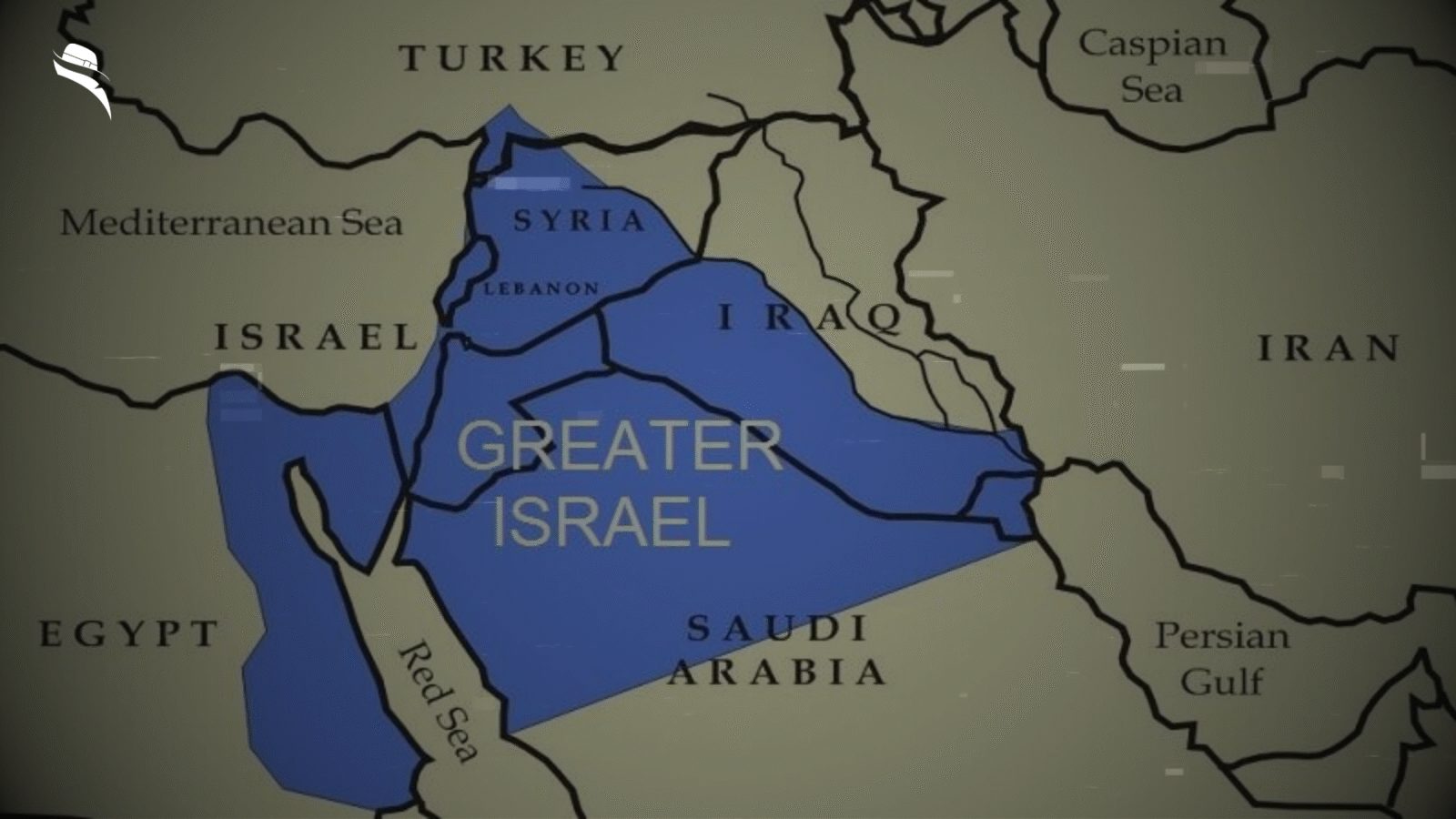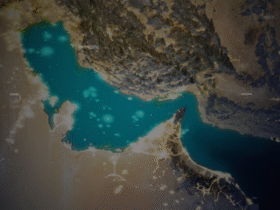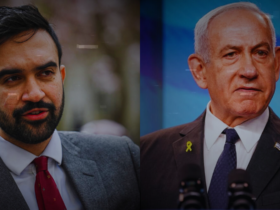The Greater Israel Movement refers to a concept that spans from ancient biblical prophecies to contemporary political ideologies. According to the Bible, Greater Israel encompasses land “from the brook of Egypt to the Euphrates,” a vast territory promised to Abraham and his descendants. This geographical definition has evolved significantly over time, shaping both religious beliefs and territorial aspirations.
In a modern context, the term “Greater Israel” is generally understood to mean extending Israel’s sovereignty to the West Bank and, in some interpretations, previously occupied territories in the Sinai Peninsula and the Golan Heights. The Greater Israel Project, as envisioned by Zionism’s founding father, Theodore Herzl, describes a Jewish State stretching “from the Brook of Egypt to the Euphrates”. However, among Israelis today, the Greater Israel plan typically refers to the territory of the State of Israel and the internationally recognized Palestinian territories. At present, at least 700,000 Israeli settlers live in unauthorized settlements in East Jerusalem and the West Bank, a reality that continues to fuel debate about what is greater Israel and its boundaries. Furthermore, recent developments in Gaza have given new life to discussions about the Greater Israel movement and its implications for regional politics.
Biblical Foundations of the Greater Israel Movement
The biblical foundations of the Greater Israel Movement stem primarily from specific passages in the Torah that outline divine territorial promises. These ancient texts serve as the cornerstone for contemporary claims about what constitutes the rightful Jewish homeland.
Genesis and the promise to Abraham
The Bible contains three distinct geographical definitions of the Land of Israel, with the most expansive appearing in Genesis 15:18. In this pivotal passage, God establishes a covenant with Abraham, stating: “To your descendants I have given this land, from the river of Egypt [the Nile] unto the great river, the River Euphrates“. This expansive territory, often referred to as “from the River to the River,” encompasses far more land than modern Israel occupies. The covenant is presented not merely as a divine promise but as a legal title to the lands between these two rivers—a deed described as “permanent and irrevocable”.
The significance of this covenant is reinforced throughout Genesis, with God telling Abraham, “To your descendants, I give this land”. Additionally, the promise is reiterated to Isaac and Jacob, creating a multi-generational claim: “And the land that I gave to Abraham and to Isaac I will give to you, and to your seed after you will I give the land” (Genesis 35:12).
Deuteronomy and territorial definitions
While Genesis presents the broadest definition, Deuteronomy offers additional territorial descriptions. One such definition appears in Deuteronomy 11:24 and 1:7, indicating territory that would be given to the children of Israel gradually throughout the years. Moreover, Exodus 23:31 outlines these boundaries as extending “from the Red Sea to the Mediterranean Sea, and from Egypt to the Euphrates River”.
The divine promise is repeatedly emphasized throughout Deuteronomy, with passages such as: “Arise, go to lead the travels before the people, so that they may come and possess the land I promised their forefathers to give them” (Deuteronomy 10:11). This constant repetition establishes the land promise as a defining leitmotif of biblical texts.
Symbolic vs. literal interpretations
Interpretations of these biblical boundaries vary considerably. Some adherents take a strictly literal view, seeing these passages as divine authorization for territorial claims spanning from Egypt to Iraq. Consequently, if fully realized today, this Greater Israel would encompass territories from Egypt, Syria, Iraq, Saudi Arabia, Kuwait, and all of Jordan, Lebanon, and historical Palestine.
Nevertheless, others view these promises symbolically rather than literally. Some biblical scholars suggest these boundaries represent spiritual dominion rather than actual territorial claims. This perspective is supported by New Testament interpretations that present restoration prophecies of Israel as fulfilled spiritually rather than literally.
The debate between literal and symbolic interpretations remains central to understanding how biblical foundations influence modern Greater Israel ideologies. For those taking a literal approach, these passages constitute the strongest possible claim to the land. For others, they represent theological concepts of covenant relationship rather than geopolitical boundaries.
Historical Evolution Through Jewish History
Throughout ancient history, the concept of a Jewish homeland evolved from actual kingdoms to an enduring ideal that sustained Jewish identity across millennia of dispersion, forming the historical bedrock upon which modern Greater Israel movement ideas would later build.
Ancient Kingdoms of Israel and Judah
The historical roots of what would eventually inform the Greater Israel plan begin with the Kingdom of Israel (united monarchy), established around 1047 BCE. Initially, a unified state under kings Saul, David, and Solomon, this kingdom fractured around 931 BCE into two separate entities. The Northern Kingdom retained the name Israel, while the Southern Kingdom became known as Judah. These kingdoms faced distinct fates: the Northern Kingdom fell to Assyrian forces around 722 BCE, resulting in the forced relocation of its inhabitants, creating what would later be called “the ten lost tribes of Israel”. The Southern Kingdom of Judah survived longer until its conquest by Babylonia in 586 BCE.
The Second Temple period and exile
The Babylonian conquest marked a pivotal shift in Jewish history when King Nebuchadnezzar destroyed Solomon’s Temple and exiled Judean elites to Babylon. This catastrophic event necessitated a profound theological reimagining, as the exile community developed concepts of “individual responsibility and universalism” along with a “strong sense of identity as a people distinct from other peoples”. Yet Jewish territorial aspirations weren’t extinguished permanently. Following Persia’s defeat of Babylon in 539 BCE, King Cyrus issued his famous edict allowing Jews to return to Jerusalem. This “Return to Zion” event culminated in the rebuilding of the Temple around 515 BCE, initiating the Second Temple period that lasted approximately 600 years (516 BCE–70 CE). During this era, the region witnessed dramatic population growth, urbanization, and agricultural development.
Diaspora and the preservation of the idea
After the Romans destroyed the Second Temple in 70 CE, Jews became a minority in most regions except Galilee. Nevertheless, this dispersal didn’t erase the concept of a promised land. Throughout the diaspora period, the idea of a Greater Israel territory remained embedded in Jewish prayers, writings, and cultural consciousness. As noted by scholars, “diaspora Jews yearned to return to the Jewish homeland and the holy Jewish city of Jerusalem, both of which are mentioned multiple times in daily Jewish prayers”. Indeed, during exile, Jewish scholars like Rashi and Maimonides kept these concepts alive through scriptural interpretations. What began as a theological framework gradually evolved, particularly during the medieval period when these thinkers “preserved their distinct cultural and religious identities, even when they were miles away from their homeland”.
Zionism and the Birth of the Greater Israel Plan
The emergence of modern Zionism in the late 19th century marked a critical shift from spiritual longing to political action, transforming ancient promises into a contemporary movement for a Jewish homeland.
Theodor Herzl and early Zionist thought
Zionism arose primarily as a response to growing anti-Semitism and exclusionary nationalist movements sweeping across Europe. Theodor Herzl, an Austro-Hungarian Jewish journalist, emerged as the architect of political Zionism despite having little connection to traditional Jewish culture. In 1896, Herzl published Der Judenstaat (“The Jews’ State”), asserting that the only solution to European anti-Semitism was establishing a state for Jews. His vision, albeit initially geographically indeterminate, eventually encompassed areas extending to Lebanon’s northern cities and the Golan Heights.
The following year, Herzl founded the Zionist Organization and convened the First Zionist Congress in Basel, Switzerland. The Congress adopted what became known as the Basel Program, declaring Zionism’s aspiration “to create for the Jewish people a home in Palestine secured under public law”. After this pivotal gathering, Herzl notably wrote in his diary: “If I had to sum up the Basel Congress in one word… it would be this: At Basel I founded the Jewish state. If I were to say this today, I would be greeted by universal laughter. In five years, perhaps, and certainly in 50, everyone will see it”.
The Balfour Declaration and British Mandate
The Balfour Declaration of November 2, 1917, fundamentally altered Palestine’s fate. Issued during World War I, British Foreign Secretary Arthur Balfour sent a letter to Lord Rothschild announcing support for “the establishment in Palestine of a national home for the Jewish people”. This declaration represented the first public expression of support for Zionism by a major political power.
Subsequently, the declaration was incorporated into the British Mandate for Palestine, approved by the League of Nations in July 1922. Article 2 made Britain responsible for creating conditions to secure “the establishment of the Jewish National Home,” notwithstanding that “nothing shall be done which may prejudice the civil and religious rights of existing non-Jewish communities”. Essentially, this document institutionalized the denial of Palestinian national rights, mentioning only their “civil and religious” rights.
Revisionist Zionism and the Irgun emblem
Ze’ev (Vladimir) Jabotinsky spearheaded a significant ideological split within Zionism by founding Revisionist Zionism in 1925. Unlike Labor Zionists, who were open to compromise, Jabotinsky advocated for “territorial maximalism” – Jewish sovereignty over all of Mandatory Palestine, including both sides of the Jordan River. His philosophy emphasized military strength through his famous “Iron Wall” doctrine: Arabs would never willingly accept a Jewish state, thus requiring an impenetrable defensive force.
The Irgun (Irgun Zvai Leumi), Revisionist Zionism’s paramilitary wing, embodied this expansionist vision through its emblem depicting both Palestine and Transjordan beneath a hand holding a gun. This symbol clearly represented the Greater Israel Project as envisioned by hardline Revisionists. The organization, whose members later formed the precursor to today’s Likud party, became infamous for its militant operations against both British authorities and Arab populations.
From 1948 to Today: Political Shifts and Settlements
Israel’s establishment in 1948 marked a pivotal moment when abstract ideological visions confronted the pragmatic realities of statehood, setting the stage for decades of territorial expansion and political transformation.
Post-1948 pragmatism vs. ideology
After Israel’s founding, theoretical debates about territorial boundaries initially gave way to political pragmatism. First and foremost, Israel never officially claimed territory beyond its 1948 boundaries in formal discourse. The early years were marked by existential struggles—creating a viable economy, absorbing refugees, and establishing diplomatic ties while facing hostile neighbors. During this period, Zionism evolved from Herzl’s utopian vision into a quest for the possible rather than the perfect. Nonetheless, as Israel never formally defined its borders, the concept of a “Greater Israel” remained alive in the imagination of religious-right Israelis as a foundational myth.
Impact of the 1967 Six-Day War
The 1967 Six-Day War fundamentally transformed both Israel and Zionism. In this brief conflict, Israel captured the West Bank, Gaza Strip, Sinai Peninsula, and Golan Heights. Correspondingly, this victory shifted Zionism from an ideology of pragmatism into one of utopianism and passivity. The territorial gains created hundreds of thousands of Palestinian refugees and brought over one million Palestinians under Israeli rule. In response, the UN passed Resolution 242, calling for Israel’s withdrawal from occupied territories in exchange for lasting peace, establishing the “land for peace” formula that would guide future negotiations. Of these captured territories, only the Sinai Peninsula was returned through the Camp David Accords.
Rise of Likud and settler movements
Likud’s rise to power in 1977 under Menachem Begin marked a decisive shift toward territorial maximalism. The original 1977 Likud platform explicitly stated that “between the Sea and the Jordan there will only be Israeli sovereignty”. Concurrently, religious-right organizations like Gush Emunim (“bloc of the faithful”) spearheaded settlement expansion in the occupied territories. Between 1967-1977, Labor governments had already established over 25 communities in the West Bank. Under Likud, dozens more settlements were constructed, many on sites with biblical significance. Currently, approximately 245,000 people live in 121 West Bank settlements.
Nation-State Law and Annexation Debates
In 2018, the Knesset passed the controversial Nation-State Law, which declares that “the right to exercise national self-determination” in Israel is “unique to the Jewish people”. In effect, this legislation establishes “Jewish settlement as a national value” and mandates that the state “will labor to encourage and promote its establishment”. For Israeli Arabs, who comprise one-fifth of Israel’s population, this was perceived as a direct affront. The law essentially affirms a hierarchical regime of citizenship and forecloses any possibility of a state for all citizens. Throughout recent years, annexation debates have intensified, with Israeli Finance Minister Bezalel Smotrich implementing unprecedented administrative measures to accelerate de facto annexation.
Controversies, Symbols, and Conspiracy Theories
Beyond territorial claims and political ideologies, symbolic elements tied to Israel have sparked heated debates about the hidden agendas of the Greater Israel Movement.
The 10 agorot coin and map allegations
In May 1990, the UN Security Council convened in Geneva specifically for Yasser Arafat, who dramatically presented the Israeli 10-agorot coin as “proof” of expansionist ambitions. Throughout that year, Arafat frequently carried these coins, claiming their design depicted a map of “Greater Israel” stretching from the Mediterranean to Mesopotamia. To bolster his case, Arafat cited a 1989 academic paper by Dr. Gwyn Rowley that analyzed the coin’s outline. The Bank of Israel firmly rejected these allegations, explaining that the design replicated an ancient coin issued by Mattathias Antigonus (40-37 BCE) featuring a seven-branched candelabrum.
Israeli flag symbolism debate
Similarly, Israel’s national flag has become entangled in controversy. Critics, primarily in Arab nations, interpret its two blue horizontal stripes as symbolizing the Nile and Euphrates rivers, supposedly marking territorial aspirations. This interpretation gained traction after Arafat promoted it in interviews. Israeli officials consistently reject this narrative, pointing out that the stripes derive from traditional Jewish prayer shawl designs.
International reactions and diplomatic tensions
These symbolic controversies periodically flare into diplomatic incidents. In March 2023, Israeli Finance Minister Bezalel Smotrich spoke in Paris behind a podium featuring a “Greater Israel” map including Transjordan, prompting tensions with Jordan. Israel’s Foreign Ministry swiftly reaffirmed its commitment to the 1994 peace treaty and respect for Jordanian sovereignty.
While most Israeli officials avoid openly endorsing the Greater Israel movement, several figures—such as ex-IDF spokesman Avi Lipkin—have spoken about it in public forums, making him just one of many voices within Israeli military and political circles who have referenced this long-debated vision.
Conclusion
The Greater Israel Movement represents a complex interplay between ancient religious texts and modern geopolitical realities. Throughout history, this concept has evolved significantly from biblical promises to Abraham into contemporary territorial claims. Biblical interpretations vary widely, with some viewing the “River to River” boundaries as literal divine mandates while others consider them symbolic spiritual teachings.
Undoubtedly, the diaspora experience preserved these territorial aspirations across centuries of exile, eventually crystallizing into political action through Theodor Herzl’s Zionist movement. After Israel’s establishment in 1948, pragmatic considerations initially overshadowed maximalist territorial visions. However, the 1967 Six-Day War fundamentally altered this trajectory, placing substantial territories under Israeli control and revitalizing debates about what constitutes Israel’s rightful boundaries.
The rise of Likud, coupled with growing settler movements, subsequently accelerated territorial expansion beyond Israel’s original borders. Additionally, controversial legislation like the Nation-State Law has further complicated questions about citizenship, rights, and national identity within these contested areas.
Though symbols like the 10-agorot coin and Israeli flag have sparked heated debates about hidden expansionist agendas, they reflect broader tensions regarding the Greater Israel concept. These controversies essentially highlight the ongoing struggle between competing visions – one seeking expanded territorial sovereignty based on historical and religious claims, another advocating for diplomatic solutions recognizing Palestinian rights.
As Israel continues navigating these complex political waters, the Greater Israel Movement remains a powerful ideological force shaping regional dynamics. The debate persists between those who view biblical promises as justification for territorial claims and those who prioritize pragmatic coexistence. Regardless of one’s perspective, understanding this movement provides crucial context for comprehending the enduring conflicts and peace efforts that define this contentious region.
FAQs
What is the Greater Israel Movement?
The Greater Israel Movement refers to a religious and political ideology that supports expanding Israel’s territory based on biblical promises made to Abraham. These claims often include lands from the Nile River in Egypt to the Euphrates River in Iraq.
Where does the term “Greater Israel” come from?
The term originates from biblical passages, particularly Genesis 15:18, which describes a covenant between God and Abraham promising land “from the river of Egypt to the great river, the Euphrates”. These texts have been interpreted by some as justification for expanded territorial claims.
Is the Greater Israel concept still relevant today?
Yes, the concept remains influential in certain political and religious circles in Israel, especially among right-wing and settler movements. Although not an official government policy, it has shaped settlement expansion and sparked regional controversy.
Does the Israeli government officially support the Greater Israel plan?
Most Israeli governments have avoided explicitly endorsing the Greater Israel ideology. However, policies such as settlement expansion and recent annexation debates reflect aspects of this vision, particularly among right-wing politicians and parties like Likud.
What role do biblical texts play in the Greater Israel Movement?
Biblical texts such as Genesis, Deuteronomy, and Exodus are foundational to the movement. They are often cited by proponents as divine justification for expanding Israel’s borders to include large parts of neighboring territories.
Who are the key figures associated with the Greater Israel ideology?
Historical figures include Theodor Herzl (indirectly), Ze’ev Jabotinsky, and leaders of the Irgun. In recent years, figures like Bezalel Smotrich and ex-IDF spokesman Avi Lipkin have made public comments aligned with Greater Israel aspirations.
What was the impact of the 1967 Six-Day War on the Greater Israel Movement?
The 1967 war significantly strengthened the movement by placing territories like the West Bank, Gaza, and Golan Heights under Israeli control. It reignited expansionist ambitions and led to a surge in settlement activity, especially by religious nationalists.
Is there any truth to the claim that Israeli symbols reflect Greater Israel aspirations?
Some critics argue that symbols like the Israeli flag or the 10-agorot coin reflect expansionist ideologies. However, Israeli authorities deny these interpretations, stating the designs have historical or religious significance unrelated to modern territorial claims.
How does the international community view the Greater Israel Movement?
Most of the international community opposes territorial expansion beyond Israel’s pre-1967 borders. UN resolutions, including 242, have called for withdrawal from occupied territories and emphasized the importance of a two-state solution.







Leave a Reply